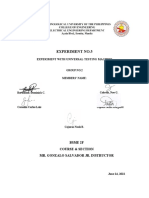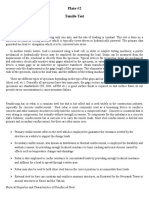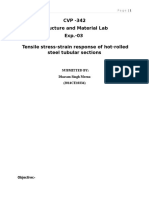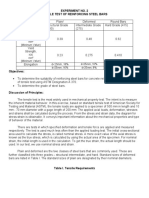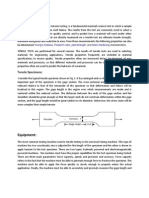Construction Materials: Monsoon Semester 2021
Construction Materials: Monsoon Semester 2021
Uploaded by
Jay PatelOriginal Description:
Original Title
Copyright
Available Formats
Share this document
Did you find this document useful?
Is this content inappropriate?
Report this DocumentCopyright:
Available Formats
Construction Materials: Monsoon Semester 2021
Construction Materials: Monsoon Semester 2021
Uploaded by
Jay PatelCopyright:
Available Formats
Construction Materials CT: 2614 1
CONSTRUCTION MATERIALS
MONSOON SEMESTER 2021
FACUTY: Bhargav Tewar
TEACHING ASSISTANT: Aanchal Arora
Aditi Bhatt (UG190043)
Material Testing Report: Steel
Test 1: Tensile and Elongation Test
Aditi Bhatt (Group 1) UG190043
Construction Materials CT: 2614 2
Practical No: 1 Date:
Tensile and Elongation Test
Aim: To determine the properties like Young's modulus, ultimate strength, and the
percentage elongation.
1.1 Reference:
- IS 1608: 2005 Metallic materials - tensile testing at ambient temperature.
- IS 432-1 (1982): Specification for mild steel and medium tensile steel bars and
hard-drawn steel wire for concrete reinforcement
1.1 Apparatus and Materials:
- Universal Testing Machine (UTM)
- Extensometer
- Scale Vernier Callipers
- Punching tools
- Measuring Scale
1.3 Procedure:
- Preparation of Specimen: Initially, the steel rod specimen is cleaned and gauge
length is marked on it. The gauge length is calculated by the formula image. The
gauge length can be marked on the specimen by punching tool.
- Range Calculation: A tensile stress value is assumed for which the maximum
expected load capacity of the rod is calculated. From this, the range is
calculated and this range is set in the UTM. Assuming working stress = 140N/mm²
Factor of safety = 3.i.e Ultimate stress = 140x3 = 420N/mm². Ultimate load = 420 x
area of c\s. From the ultimate load, range to be used can be fixed.
- Placing the Specimen: The handle is operated such that the specimen firmly fits to
the top base. The left valve is kept in a fully closed position and the right valve in
a normal open position. Open the right valve and close it after the lower table is
slightly lifted. Adjust the load pointer to zero with the zero adjusting knobs. By
operating the handle, lift the lower crosshead chuck up and grip firmly the lower
part of the specimen. Once the specimen is placed, the jaws are locked.
- Placing Extensometer: Fix the extensometer on the specimen and set the reading
to zero.
Aditi Bhatt (Group 1) UG190043
Construction Materials CT: 2614 3
- Load Application: Turn the right control valve slowly to open position to get the
desired loading rate. When the specimen is under load, slowly unclamp the
locking handle. Note the extension at a convenient load increment. Extensometer
must be removed before reaching the yield point. The right valve is used to apply
the load and the left valve is used to release the load on the specimen.
- Important Load Points: With the increase in load at some point, the load pointer
remains stationary. Load corresponding to this indicates the yield point. With
further increase in load, the pointer goes backward and specimen breaks. The
load before this breaking is the ultimate load. The load at the breaking of the
specimen is called as the breaking load.
- Close the right control valve and take out the broken piece. Open the left control
valve to pump the oil back. Maximum capacity of the specimen can be seen
against the red pointer. Measure the diameter of the specimen at the neck.
Change in length is obtained from reading recorded from extensometer.
- Therefore, Strain = Change in length/Original Length Stress at different values of
strains is also determined as, Stress = Load /Area; With different values of stress and
corresponding strains, the graph is plotted.
1.4 Observation Table:
- Aluminum Rod
Sample Type Aluminum Final Gauge 93.36 mm
rod Length
Diameter 16.01 mm Gauge Length 80.32 mm
Final Dia 12.43 mm
RESULTS
Maximum Force 73.920 KN Yield Load 33.690
(Fm) kN
Disp. at Fm 40.800 Yield Stress 0.167 kN/mm ²
mm
Aditi Bhatt (Group 1) UG190043
Construction Materials CT: 2614 4
Max. Disp. 51.000 mm YS/UTS Ratio 0.456
c/s Area (So) 201.394 mm ²
Tensile Strength 0.367 kN/mm ²
(Rm)
Elongation 16.24%
Reduction in Area 39.72%
(Z)
- TMT Rod
Sample Type TMT
Length 1,003.0 mm Gauge 80.094 mm
Length
Weight 1.541 kg
RESULTS
Maximum Force (Fm) 128.130 kN Yield Stress 0.280 kN/mm ²
Disp. at Fm 52.300 mm YS/UTS Ratio 0.45
Max. Disp. 62.900 mm
c/s Area (So) 206.227 mm ²
Tensile Strength (Rm) 0.621 kN/mm ²
Elongation 78.53%
Yield Load 57.660 kN
Aditi Bhatt (Group 1) UG190043
Construction Materials CT: 2614 5
- Steel Rod
Sample Type Stainless Steel Final Gauge 427.66 mm
Length
Diameter 15.9 mm Gauge Length 404 mm
Final Dia 8.56 mm
RESULTS
Maximum Force 145.710 kN Yield Load 67.200 kN
(Fm)
Disp. at Fm 80.600 mm Yield Stress 0.338 kN/mm ²
Max. Disp. 112.500 mm YS/UTS Ratio 0.461
c/s Area (So) 198.636 mm ²
Tensile Strength (Rm) 0.734 kN/mm ²
Elongation 5.86%
Reduction in Area 71.02%
(Z)
1.4 Significance: Tensile tests are used to determine how materials will behave under
tension load. In a simple tensile test, a sample is typically pulled to its breaking
point to determine the ultimate tensile strength of the material.
1.5 Conclusion: We were able to successfully conduct tensile test on aluminium
rod, TMT rod andsteel rod using the universal testing machine, from the data
obtained we were ableto successfully obtain the young’s modulus, ultimate tensile
strength and yield stressvalues of the three rods. By comparing the values of all
metals, we can see that steelrod has higher values in all of the three properties
which mean it is stronger andmore ductile than aluminium and TMT rod.
Aditi Bhatt (Group 1) UG190043
You might also like
- BS en Iso 11644-2022Document23 pagesBS en Iso 11644-2022Marius ChiroscaNo ratings yet
- Young's Modulus Experiment 1Document16 pagesYoung's Modulus Experiment 1Yudhisthira82% (65)
- Standard Testing Procedure - Tensile TestingDocument3 pagesStandard Testing Procedure - Tensile Testingdevendrasingh2021100% (1)
- Tensile Test Report - COMPLETEDocument9 pagesTensile Test Report - COMPLETEJasanta Jinor50% (2)
- Tensile Strength of Reinforcement Steel Bar PDFDocument4 pagesTensile Strength of Reinforcement Steel Bar PDFMayolitesNo ratings yet
- S2-Tensile Test of Mild SteelDocument7 pagesS2-Tensile Test of Mild SteelAltamashuddin KhanNo ratings yet
- Iso 3574 1999 en PDFDocument8 pagesIso 3574 1999 en PDFGus Ortega PedrazaNo ratings yet
- Group 3 - Tensile TestDocument25 pagesGroup 3 - Tensile TestKimi AzmanNo ratings yet
- Group 2 - Experiment No. 5 Tensile TestDocument5 pagesGroup 2 - Experiment No. 5 Tensile TestSevi DumpNo ratings yet
- Engineering Council Certificate Level Engineering Materials C102 Tutorial 6 - Materials TestingDocument11 pagesEngineering Council Certificate Level Engineering Materials C102 Tutorial 6 - Materials TestingcataiceNo ratings yet
- Plate #2 Tensile TestDocument6 pagesPlate #2 Tensile TestChristian D. AllanaNo ratings yet
- Rashmiranjan Si-716CE3008 (Group-7) TensileDocument9 pagesRashmiranjan Si-716CE3008 (Group-7) TensileRASHMIRANJAN SINo ratings yet
- Strength of Materials Lab-Ahmed AlsharaDocument24 pagesStrength of Materials Lab-Ahmed AlsharaMṜ ΛßßΛSNo ratings yet
- Pin On Disc DryDocument8 pagesPin On Disc DryHrushikesh KhairnarNo ratings yet
- Pin On Disc WetDocument8 pagesPin On Disc WetHrushikesh KhairnarNo ratings yet
- Applied Mechanics (ME 14.101) Tutorial Sheet-6: (Tension, Compression & Shear)Document1 pageApplied Mechanics (ME 14.101) Tutorial Sheet-6: (Tension, Compression & Shear)atulkumargaur26No ratings yet
- Strength of Materials-Ii Experiment 3 "To Perform Tension Test On Mild Steel Bars and Determine Principal Stresses Using Analytical Method"Document13 pagesStrength of Materials-Ii Experiment 3 "To Perform Tension Test On Mild Steel Bars and Determine Principal Stresses Using Analytical Method"Fahim AnwerNo ratings yet
- Tensile TestDocument14 pagesTensile TestAysha AlNo ratings yet
- Tensile Test - Intro & TheoryDocument8 pagesTensile Test - Intro & TheoryaidasuhanumNo ratings yet
- Tensile Testing Mild Steel As Received Sample: Experiment 1 Group1Document9 pagesTensile Testing Mild Steel As Received Sample: Experiment 1 Group1Adarsh BujadeNo ratings yet
- Part A: Tensile Testing of Mild Steel As Received SampleDocument7 pagesPart A: Tensile Testing of Mild Steel As Received SampleAdarsh BujadeNo ratings yet
- FEU Institute of Technology School of Mechanical Engineering MEMATSCILAB: Materials Science Laboratory ManualDocument9 pagesFEU Institute of Technology School of Mechanical Engineering MEMATSCILAB: Materials Science Laboratory ManualJohn Paul BersabeNo ratings yet
- Ce102 Test Report PrestentationDocument5 pagesCe102 Test Report PrestentationIsrael PopeNo ratings yet
- MOS Lab ReportDocument25 pagesMOS Lab ReportTalha MustafaNo ratings yet
- cvp342 2Document7 pagescvp342 2Alok Kumar MeenaNo ratings yet
- Rubber Belt Conveyor Calculations (ISO 5048: 1989 E) : BC 2304 NDDocument8 pagesRubber Belt Conveyor Calculations (ISO 5048: 1989 E) : BC 2304 NDmah moud100% (1)
- 09.JiaYiing E.materials100 ReportDocument10 pages09.JiaYiing E.materials100 ReportJack JongNo ratings yet
- Mos Lab Manual PDFDocument34 pagesMos Lab Manual PDFs.rihanaNo ratings yet
- Design Calculation of Tower t1&t2Document57 pagesDesign Calculation of Tower t1&t2Allan MwesigwaNo ratings yet
- Design Calculation of Tower T3Document52 pagesDesign Calculation of Tower T3Allan MwesigwaNo ratings yet
- BMT LAB NEW Final111111 PDFDocument85 pagesBMT LAB NEW Final111111 PDFmohanNo ratings yet
- Laboratory Manual of Tensile TestDocument11 pagesLaboratory Manual of Tensile TestVIPAN KUMARNo ratings yet
- Queastion Bank MOM 22 26Document5 pagesQueastion Bank MOM 22 26karvaminNo ratings yet
- Improved Methods For Rapid Load Tests of Deep FoundationsDocument8 pagesImproved Methods For Rapid Load Tests of Deep FoundationslimaNo ratings yet
- Aisi410 M29002 PDFDocument1 pageAisi410 M29002 PDFK.s. Raghavendra KumarNo ratings yet
- Clock Spring CS600 Quad Qualification Test ReportDocument7 pagesClock Spring CS600 Quad Qualification Test ReportMOHD ASHRAF MOHD ROSITNo ratings yet
- 1 Chapter 1 StrenghtDocument37 pages1 Chapter 1 Strenghttest 2No ratings yet
- Test Certificate Meft: Peenya - BangaloreDocument1 pageTest Certificate Meft: Peenya - BangaloreK.s. Raghavendra KumarNo ratings yet
- AC MainsDocument2 pagesAC Mainsaafaf.sdfddfa100% (1)
- Lab ReportDocument8 pagesLab ReportHenrique PradoNo ratings yet
- Material Testing Lab ManualDocument29 pagesMaterial Testing Lab ManualJithin Thomas ANo ratings yet
- Experiment 2Document2 pagesExperiment 2Ahmetgözde GözdeahmetNo ratings yet
- Ae1100 13000 13.818 MW 32.500 MH N MMDocument2 pagesAe1100 13000 13.818 MW 32.500 MH N MMredlandsNo ratings yet
- 8m Unipole Design Calculation (TM Kuala Kangsar) .Document25 pages8m Unipole Design Calculation (TM Kuala Kangsar) .Tam Eng Sun100% (1)
- Material Testing LabDocument79 pagesMaterial Testing LabBrijesh VermaNo ratings yet
- Final - Solid Mechanics Answer End SemDocument3 pagesFinal - Solid Mechanics Answer End Sem20231113038No ratings yet
- Determination of Strain in A Steel Bar PDFDocument8 pagesDetermination of Strain in A Steel Bar PDFEarl AradoNo ratings yet
- Mem-402-Mos Final QB-2015Document9 pagesMem-402-Mos Final QB-2015Rohit DiwakarNo ratings yet
- Sonometer ExperimentDocument4 pagesSonometer ExperimentRajeev Verma63% (8)
- 1 Tension Test of Steel BarsDocument3 pages1 Tension Test of Steel Barsrasha100% (1)
- Tension Test in Steel and Aluminum: ASTM Designation EDocument16 pagesTension Test in Steel and Aluminum: ASTM Designation ERod PasionNo ratings yet
- Ce 14444 Lab7Document5 pagesCe 14444 Lab7Owen Francis Arles MaongatNo ratings yet
- Ultimate Tensile StrengthDocument7 pagesUltimate Tensile StrengthAgung Pratama JuniantoNo ratings yet
- Basic Structural DesignDocument16 pagesBasic Structural DesignmanojmoryeNo ratings yet
- MOS Lab Manual - NewDocument41 pagesMOS Lab Manual - NewPavan Kalyan SuryavamshiNo ratings yet
- Wireless Power Transfer: Using Magnetic and Electric Resonance Coupling TechniquesFrom EverandWireless Power Transfer: Using Magnetic and Electric Resonance Coupling TechniquesNo ratings yet
- O level Physics Questions And Answer Practice Papers 2From EverandO level Physics Questions And Answer Practice Papers 2Rating: 5 out of 5 stars5/5 (1)
- Mechanical Characterization of Materials and Wave Dispersion: Instrumentation and Experiment InterpretationFrom EverandMechanical Characterization of Materials and Wave Dispersion: Instrumentation and Experiment InterpretationYvon ChevalierNo ratings yet
- The Tate Modern: London, United KingdomDocument26 pagesThe Tate Modern: London, United KingdomJay PatelNo ratings yet
- Vertical Alignment StepsDocument6 pagesVertical Alignment StepsJay PatelNo ratings yet
- Comparison of Different Survey: Jay Patel - Uct20064Document8 pagesComparison of Different Survey: Jay Patel - Uct20064Jay PatelNo ratings yet
- Case Study: New Artist's Residency by Toshiko MoriDocument10 pagesCase Study: New Artist's Residency by Toshiko MoriJay PatelNo ratings yet
- Case Study-Kizhi Pogost Church: by - Tanya Shah UG191401Document24 pagesCase Study-Kizhi Pogost Church: by - Tanya Shah UG191401Jay PatelNo ratings yet
- Class 2 - Functional Road Hierarchy and Geometric Design of RoadsDocument88 pagesClass 2 - Functional Road Hierarchy and Geometric Design of RoadsJay PatelNo ratings yet
- Lecture 7 - Horizontal AlignmentDocument55 pagesLecture 7 - Horizontal AlignmentJay PatelNo ratings yet
- D828 Tração de Papel e PapelãoDocument8 pagesD828 Tração de Papel e PapelãoRenan HenriquesNo ratings yet
- A Simplified Procedure To Determine Post-Necking True Stress-Strain Curve From Uniaxial Tensile Test of Round Metallic Specimen Using DICDocument7 pagesA Simplified Procedure To Determine Post-Necking True Stress-Strain Curve From Uniaxial Tensile Test of Round Metallic Specimen Using DICSunil GoyalNo ratings yet
- Questions For InterviewDocument4 pagesQuestions For InterviewImran NazirNo ratings yet
- LTA Specs For CouplersDocument4 pagesLTA Specs For CouplerssawwahwahNo ratings yet
- Comparison of Bond Strength or Ply Adhesion of Similar Laminates Made From Flexible MaterialsDocument3 pagesComparison of Bond Strength or Ply Adhesion of Similar Laminates Made From Flexible MaterialslexandroNo ratings yet
- WS02 Welding Oxyfuel - MIGDocument2 pagesWS02 Welding Oxyfuel - MIGsherif115040 BueNo ratings yet
- As 1855-2008 Methods For The Determination of Transverse Tensile Properties of Round Steel PipeDocument7 pagesAs 1855-2008 Methods For The Determination of Transverse Tensile Properties of Round Steel PipeSAI Global - APACNo ratings yet
- ME 303 Study Set PDFDocument44 pagesME 303 Study Set PDFFajar RumantoNo ratings yet
- ScopeDocument3 pagesScopeqamgr.sudairNo ratings yet
- Cement and Concrete Research: Amin Abrishambaf, Mário Pimentel, Sandra NunesDocument13 pagesCement and Concrete Research: Amin Abrishambaf, Mário Pimentel, Sandra NunesJoseluis Dejesus AnguloNo ratings yet
- A1081A1081M-12 Standard Test Method For Evaluating Bond of Seven-Wire Steel Prestressing StrandDocument5 pagesA1081A1081M-12 Standard Test Method For Evaluating Bond of Seven-Wire Steel Prestressing StrandDiego Egoávil MéndezNo ratings yet
- Me136p Exp2 Tensile Test of Reinforcing Steel BarsDocument15 pagesMe136p Exp2 Tensile Test of Reinforcing Steel BarsJohn Henry SalvadoNo ratings yet
- DD Cen TS 14689-2006Document12 pagesDD Cen TS 14689-2006Виктор ИсакNo ratings yet
- Tensile TestDocument20 pagesTensile TestDinesh RaviNo ratings yet
- PDI Checklist: Main Accessories Shall Be As Per Our Recommended Brands. Servo Driving System: SiemensDocument4 pagesPDI Checklist: Main Accessories Shall Be As Per Our Recommended Brands. Servo Driving System: SiemensBANBROS ENGINEERING PVT. LTD.No ratings yet
- HTC2012 HyperStudy TrainingDocument27 pagesHTC2012 HyperStudy TrainingerkantalayNo ratings yet
- Aashto M 55 03 PDFDocument5 pagesAashto M 55 03 PDFCristian RubioNo ratings yet
- Tensile Testing Standards and SpecificationsDocument3 pagesTensile Testing Standards and SpecificationsTestronix InstrumentsNo ratings yet
- Linepipe Induction Bends (AMENDMENTS/SUPPLEMENTS TO DEP 31.40.20.30-Gen. AND DEP 31.40.20.31-Gen.)Document28 pagesLinepipe Induction Bends (AMENDMENTS/SUPPLEMENTS TO DEP 31.40.20.30-Gen. AND DEP 31.40.20.31-Gen.)resp-ectNo ratings yet
- 3022 - Material Scoince and MetrologyDocument57 pages3022 - Material Scoince and Metrologysangei2093No ratings yet
- InTech-Mechanical Properties of Mems MaterialsDocument12 pagesInTech-Mechanical Properties of Mems MaterialsNico Ortega MirandaNo ratings yet
- Wide Width Tensile StrengthDocument4 pagesWide Width Tensile StrengthMohit SharmaNo ratings yet
- Tensile TestingDocument4 pagesTensile TestingNaveed AfzalNo ratings yet
- ASTM C1265 Standard Test Method For Determining Tensile Properties of Insulating Glass Edge Seal For Structural Glazing ApplicationsDocument6 pagesASTM C1265 Standard Test Method For Determining Tensile Properties of Insulating Glass Edge Seal For Structural Glazing ApplicationsResearch DevelopmentNo ratings yet
- D3822 - 2007 - Standard Test Method For Tensile Properties of Single Textile FibersDocument10 pagesD3822 - 2007 - Standard Test Method For Tensile Properties of Single Textile Fibersmargarethsm50% (2)
- Abeysinghe, Chanaka M. Thambiratnam, David P. Perera, Nimal JDocument30 pagesAbeysinghe, Chanaka M. Thambiratnam, David P. Perera, Nimal JSäbrinä ShukrìNo ratings yet
- Conf 15325 1550052824 28.IJMPERD - Venkatrao PDFDocument16 pagesConf 15325 1550052824 28.IJMPERD - Venkatrao PDFVamsi KrishnaNo ratings yet
- Determination of Yarn Tensile Strength - Textile LearnerDocument14 pagesDetermination of Yarn Tensile Strength - Textile LearnerJ.SathishNo ratings yet









